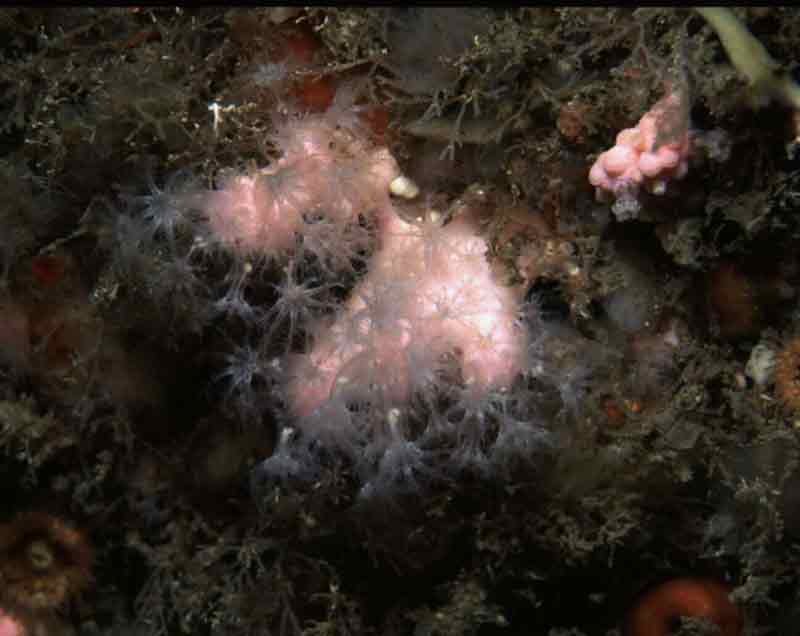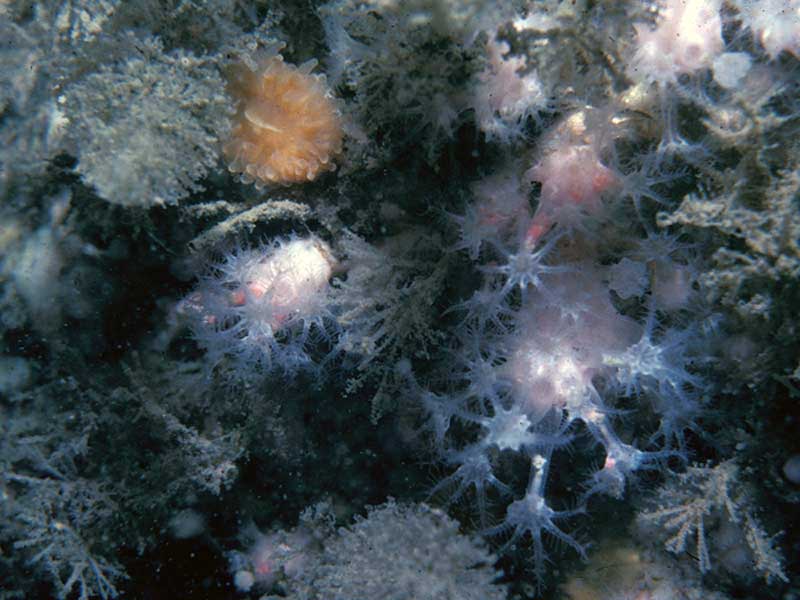Pink sea fingers (Alcyonium hibernicum)
Distribution data supplied by the Ocean Biodiversity Information System (OBIS). To interrogate UK data visit the NBN Atlas.Map Help
| Researched by | Joelene Hughes | Refereed by | Admin |
| Authority | (Renouf, 1931) | ||
| Other common names | - | Synonyms | Parerythropodium coralloides (Pallas, 1766), Parerythropodium hibernicum Renouf, 1931, Alcyonium pusillum |
Summary
Description
Recorded distribution in Britain and Ireland
Alcyonium hibernicum has been identified from four sites in Ireland and the Isle of Man. Previous records for Parerythropodium coralloides at other locations in Britain and Ireland are now thought to have been Alcyonium hibernicum.Global distribution
McFadden (1999) found two forms of Alcyonium hibernicum.One form is found around Britain and Ireland also on the north Atlantic coast of France. The second form is found off the southern coast of Portugal.Habitat
Occurs on shaded vertical or overhanging rock surfaces in the shallow subtidal, between 1-30 m depth. Requires at least moderate water movement, to provide a supply of food particles. Alcyonium hibernicum requires some shelter from wave action, such as that provided by the landward side of overhanging rocks.Depth range
-Identifying features
- Colonies are typically lobate or digitate rather than encrusting.
- Pink sclerites are found in the polyp whereas the tentacular sclerites in the coenenchyme are either pink, white or a mix of the two colours.
- Very similar in colour and morphology to Alcyonium coralloides.
Additional information
The taxonomy of the species has been recently revised by McFadden (1999). Alcyonium hibernicum was previously described as Alcyonium coralloides and Parerythopodium coralloides. Alcyonium hibernicum was also named Alcyonium pusillum by Tixier-Durivault and Lafargue (1966). McFadden (1999) considered Alcyonium hibernicum and Alcyonium coralloides to be separate species and suggested that they represented clades of five different species based on allozyme polymorphisms.Listed by
Bibliography
Hartnoll, R.G., 1977. Reproductive strategy in two British species of Alcyonium. In Biology of benthic organisms, (ed. B.F. Keegan, P.O Ceidigh & P.J.S. Boaden), pp. 321-328. New York: Pergamon Press.
McFadden, C.S., 1999. Genetic and taxonomic relationships among northeastern Atlantic and Mediterranean populations of the soft coral Alcyonium corallioides. Marine Biology, 133, 171-184.
Datasets
Centre for Environmental Data and Recording, 2018. Ulster Museum Marine Surveys of Northern Ireland Coastal Waters. Occurrence dataset https://www.nmni.com/CEDaR/CEDaR-Centre-for-Environmental-Data-and-Recording.aspx accessed via NBNAtlas.org on 2018-09-25.
NBN (National Biodiversity Network) Atlas. Available from: https://www.nbnatlas.org.
OBIS (Ocean Biodiversity Information System), 2025. Global map of species distribution using gridded data. Available from: Ocean Biogeographic Information System. www.iobis.org. Accessed: 2025-07-21
Citation
This review can be cited as:
Last Updated: 08/06/2007




